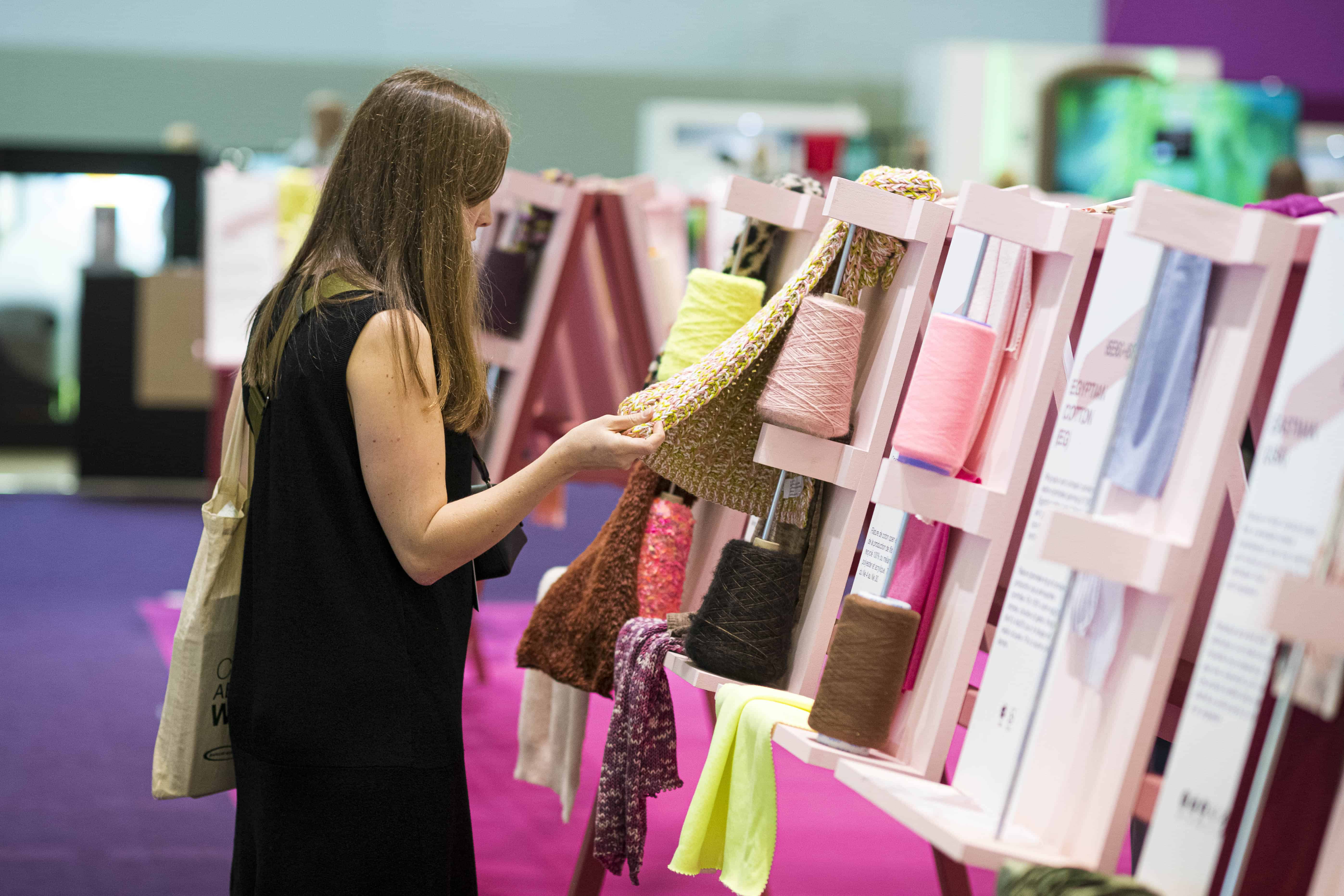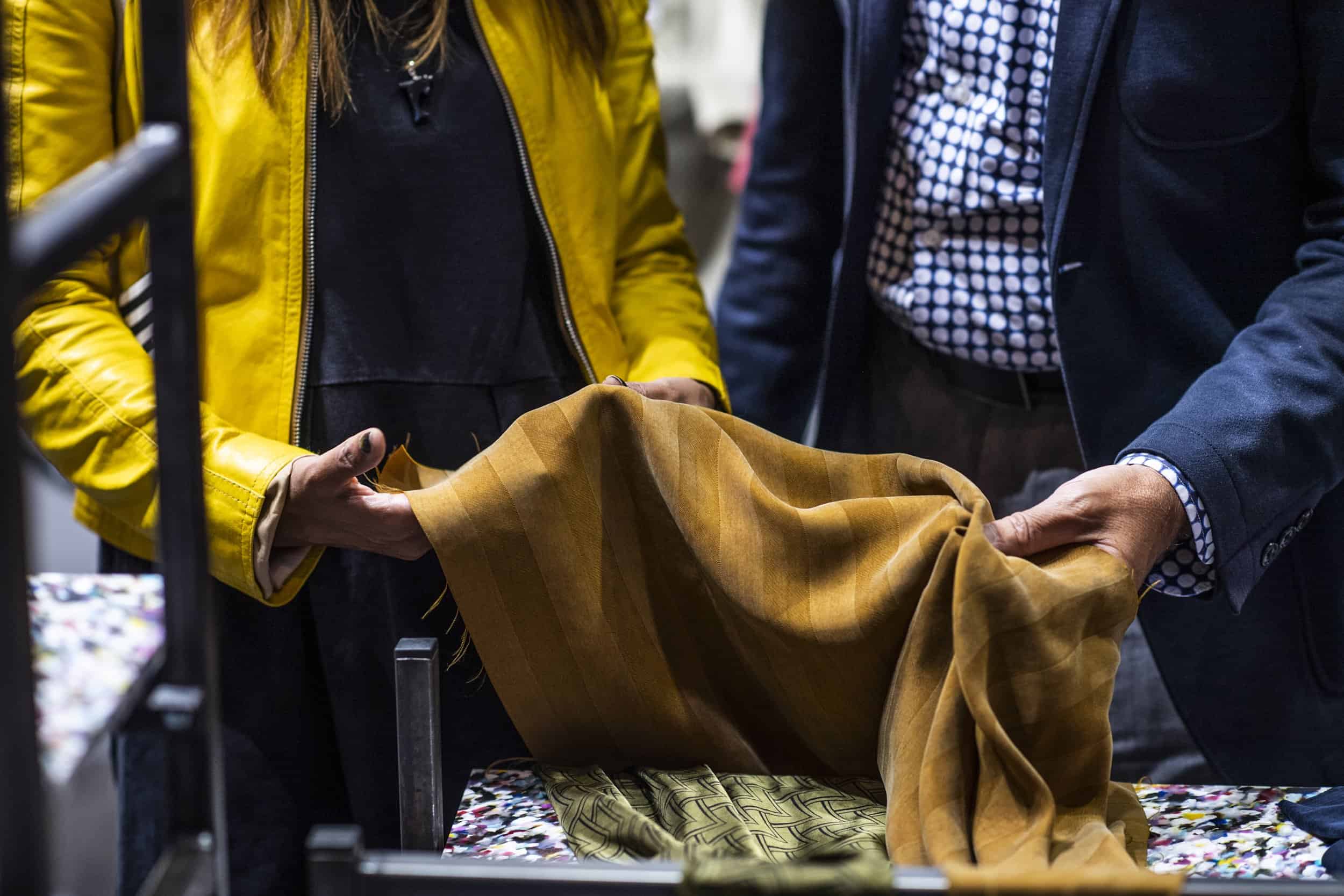Together with Première Vision’s Fashion Director Pascaline Wilhelm, and multidisciplinary artist Bart Hess, I have uncovered some of the insights of working with new technologies and virtual reality, as well as their effects on how we think about our professions. Could feelings that liberate us in virtual dimensions become increasingly tactile? Are we ready to explore new ways of being that trick our brains?
The work of Bart Hess has highly developed tactility of materials in relation to the human body, technology as well as the objects. His “outer layers of unfamiliar hybrid species” juxtaposed with moving image embrace another dimensions in a remarkable and distinctive manner. But Hess’ works convey considerably more than some worlds of imagination. Complexities of his images inspire awe and terror, where the gravity cease to exist and the exploration of the eponymous psychical innovations evoke future upheaval within textile industry. Here, interactive experiences were created to embrace sensory stimuli and showcase textiles in the closest to the real feeling way possible. VR is all about immersion focused on sight and sound thus when new set of strategies for sharing intimate feelings, especially on a mental or spiritual level enter the equation, fluidity of questioning the world’s multiplicity becomes a powerful tool. This opens up many chances for those that intuitively seek out states outside of the realms of ordinary experience of the products presentation.

Première Vision Paris, 2019
During Première Vision, the Parisian textiles and fabric fair, I had the opportunity to see and experience the most innovative and sustainable designs – how they are made, what is their factual content and why they are produced. Asking yourself “why” creates mindful creation without undesirable waste. Fashion is driven by the capitalist system which creates artificial needs for products that we truly can survive without. These fabric-designers and textile-engineers, encourage visitors to confront themselves with solutions to problems that has arisen and could unimaginably change future. Solutions that will incorporate recycled, reused as well as reworked pieces. Sustainability should not be a trend which pass into oblivion. Clothes are a medium of choice and nobody will wear them on a dead planet. This is part of the spirit of our times motivated by social, cultural and environmental events that shaped our current attitude.
Huge developments in the digital world are underway. We can feel them coming and taking over the current state like Marianne from Liberty Leading the People by Eugène Delacroix. We live in a time of turbulence and acknowledgement of our cognitive limits within the natural world as human that technology may bring to an end.
Marta Klara Sadowska: New technologies occupy a major space in the framework of Première Vision. Thanks to an increasing demand, and greater available financing for textile research, materials and fabrics have emerged as a point of focus within the areas of interaction, sense and experience. How have you approached the creation of the somatic experience in virtual reality?
Bart Hess: In regards to this virtual reality experience, I tried to bring across a bit more than you can get from the video. In virtual reality, the process is more democratic; you watch parts that you want to observe. Because it all occurs in apparent real-time, it conveys more convincingly the qualities of textiles. In my case I manipulated all the qualities again, by playing with time and gravity too. I think that on an intuitive level, you almost want to touch the materials that are not there; it tricks the brain quite completely.

Première Vision Paris, 2019
MKS: Pascaline, how do you feel about new technologies entering your life, do you need to adjust some of your practices?
Pascaline Wilhelm: Nowadays technology in textiles is very modest; you do not see or touch it but it has a reaction on you. It is not necessary to visually reveal the complex processes. Everyone in the fair wants to create a textile that protects as well as embraces human beauty. Today in the world we are in a very egocentric moment – through personalisation and new ways of consumption everybody is seeking to have their own answers. So how can we make this aspect more positive – as a fabric developer, as a garment manufacturer and the brand? It is a need to be different but to adjust at the same time.
MKS: Bart, can you share what was the first idea behind your project and how you started working on it?
BH: I started with the exploration of the technique – how I translate my work into virtual reality as well as manipulate videos and images. Also, Pascaline came up with words, concepts and silhouettes that would best represent the new season of Première Vision. Having that support I started making some sort of costumes in my studio. At the final stage, location and movement were crucial decision to undertake too. I like that virtual reality is sort of a dream composed within the duality of making sense and not – you see images and you try to make a story.
MKS: How will presenting and making clothes change in the future? What promise is the textile industry making?
PW: The notion of the reality is always to be improved. It is always a game between thinking and imagining the next reality. Things are open – you can make a collection for your avatar, fantastique!

Première Vision Paris, 2019
MKS: What is something undergoing development which you are particularly excited about?
PW: We are excited about the many techniques which allows more automated work. Now the act of sewing can be fully digitalised, and the digital body mapping allows to make patterns more quickly, more efficiently. I also look forward to a time in the next few years when three-dimensional printing will be vastly used in manufacturing clothing. To make a garment is like being an architect – imbedding movement in the permanence of the material. I wish that in a close future, you could draw you garment in the morning, have it printed in 3-dimensions, and be able to recycle it in the evening so you could draw another one the next morning. “
MKS: What criteria have you been looking at while choosing the most innovative textile pieces this year?
BH: My background is more in the field of art, so, when I was preparing for the selection, I had to acquire more technical knowledge. When I saw a textile, I was paying attention to the sensation, movement, tactility, the feel – the qualities I work with myself. Sometimes in my imagery textiles can look soft but the feel is very different, even horrible on a model’s body.
PW: It was one of the reasons we asked Bart to be the president of the jury. When you are a specialist who is always surrounded by experts you have your eyes on innovations, so sharply that you lose a sense of surprise and freshness. The new link that can exist between art and fashion is like an old love story. For me the sense of beauty is made with a different kind of art.
MKS: How about the idea for curation this season?
PW: Each season has a different mission to develop. I could not presume six months before, what it is that I want. Nevertheless, thanks to our international consultation team I am particularly fond of the collaborative aspect of curation.

Première Vision Paris, 2019
MKS: Do you feel like new technologies are prefiguring some dystopian visions for the future?
PW: As far I am concerned it is ultra positive. Easy to live, wear and think. Freedom of the movement.
BH: I found myself in a position where it was hard to create something with a fresh view. My work has dark shades, but I can find balance. It is very connected to the textile industry. Because of my background, I do conceptual design with a specialisation in fabric – my DNA is there. Sometimes I produce my own textiles, which are never really wearable. I was intrigued by the leather section where there was a display of different recycling possibilities, for example, bleaching without any heavy metal and the its’ unusually high quality really surprised me. There is a just a lot of inspiration for me to uncover.
Interviewed by Marta Klara Sadowska

Première Vision Paris, 2019







